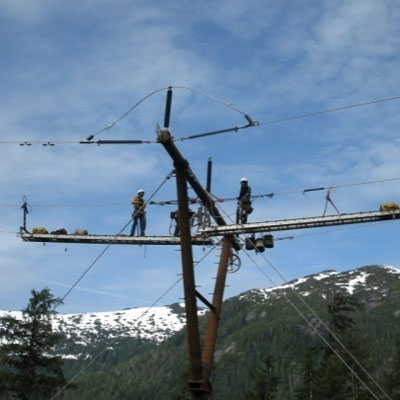From feasibility studies, route selection, right of way/easement acquisition, and permitting through final design to construction and final inspection, EPS has exceptional capabilities to provide the expertise necessary to successfully complete both underground and overhead transmission projects with distribution, communication and substation components. Our staff’s project experience has varied from sub-transmission through 345 kV and includes a wide range of design and construction approaches. The firm’s experience includes a wide range of voltage levels for new, upgraded, and repaired facilities. Our staff has experience studying feasibility and providing preliminary and final designs for lines with a wide variety of foundation, structure and configuration types. Each project has its own unique challenges, and special designs have been developed for projects with widely varying foundation, climate, and terrain conditions. EPS uses specialized transmission computer programs including SAG10, PLS-CADD, PLS-POLE, PLS-TOWER, PLS-SAPS, CAISSON, and LPILE.
The following is a representative sampling of EPS’s experience and technical competence on transmission and substation projects:
Canyon Substation 230 kV and 115 kV Transmission Lines
EPS provided transmission engineering services for interconnecting BPA’s South Tacoma 230 kV Substation to Tacoma Power’s new Canyon 230/115 kV Substation. Tubular steel H-frame structures were used for the 230 kV circuit. Additionally, two separate 115 kV lines using steel poles were designed to connect the new substation to Tacoma’s LaGrande double circuit 115 kV line at two tap locations. Drilled pier foundations were used for all the steel structures.
Lake Chelan Submarine Cable Replacement Project
For this project, EPS provided submarine cable design, routing options, cost estimates, cable specifications, and engineering support during construction. Utilities in the state of Washington were interviewed to determine preferences with cable types and manufacturers. Material quotes were solicited from cable manufacturers and cost estimates were prepared for three different options. After Chelan selected an option, drawings and specifications were completed and EPS assisted the District in selecting a cable manufacturer and procuring the cable. A riser structure at the Yacht Club and a pad mounted switch on the Manson side of the lake were also included in the design and construction. Because the existing cable was in relatively good condition, it was kept in service and the new cable was designed around it to provide a redundant feed across the lake.
Priest Rapids Avian Collision Mitigation to 230 kV Transmission Lines
EPS provided structural analysis services to the District for 13 spans crossing the Columbia River or nearby sloughs that were candidates for adding bird flight diverters (BFDs) to reduce avian collisions. All supporting structures were 230 kV, steel lattice towers ranging in height from 74 to 248 feet. Non-linear, finite element analysis was performed to determine stresses in structure elements and foundations in order to assess if the proposed improvements met the District’s loading criteria.
115 kV Transmission Line Upgrades
EPS provided engineering services to the District to upgrade several of their 115 kV lines to use ACSS high-temperature conductor. Four projects totaling over 46 miles in length were field inspected and re-designed for the new, larger conductor. Structures and materials were changed out where required to maintain strength and clearances requirements. The new conductor is designed to operate at 200°C (392°F). The four projects were Rocky Ford – Larson, East Quincy – Rocky Ford, Columbia – Ancient Lake, and Larson – Moses Lake.
Marathon to Ivanoff Lake 115 kV Intertie
EPS provided professional and engineering services necessary to permit, acquire legal access, design and prepare for construction a 115 kV transmission line between the Bernice Lake and Soldotna Substations. The line is approximately seven miles long and includes 25 kV distribution and communication underbuild on wood poles. Sections of the line crossed wet peat bogs, requiring pile foundations. This project required extensive efforts to resolve conflicts between the operational aspects of the Kenai Airport facilities and the project which was located partially on airport lands.
Teeland to Redington 115 kV Upgrade
EPS (D&L) is providing full design services for 10 miles of new 115 kV transmission line and expansion of the Redington Substation. The line interconnects Redington Substation with Teeland Substation, replacing a 34.5 kV line. The new line and substation addition are designed and detailed to maintain existing 34.5 kV facilities energized during construction. The line is also designed for upgrading existing distribution underbuild facilities.
Lincoln Avenue Line Relocation – 115 kV Transmission
When a half mile section of Lincoln Avenue needed to be elevated onto an overpass to relieve freight lane congestion, Tacoma Power retained EPS to relocate several 115 kV and 13.8 kV circuits entering and exiting a nearby substation. New tubular steel poles as tall as 105 feet were used to support transmission, distribution and several secondary and communication circuits. Drilled piers 60 feet in depth were used to support the poles in the former tidal flats area. EPS provided complete transmission engineering including material procurement and on-site inspection.
Swan Lake – Tyee Lake 138 kV Intertie
EPS (D&L) provided complete transmission engineering and construction management for this 57-mile long 138 kV transmission line connecting the Swan Lake and Tyee Lake Hydroelectric projects. The line traverses the extremely rugged and remote terrain of Southeast Alaska. There are four major water crossings, each with a span longer than a mile, the longest being nearly 6,900 feet. The entire transmission line, which included 350 tubular steel structures, was constructed from floating work camps using helicopters. EPS worked with the line contractor to provide value-engineering. These efforts reduced final construction costs by nearly 20% from other design teams.

